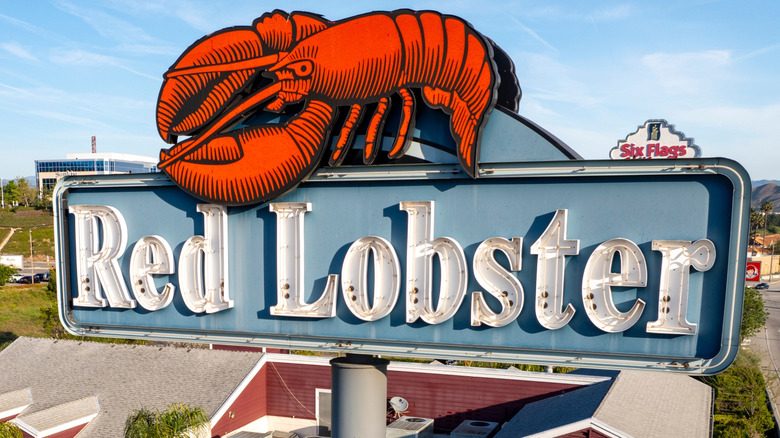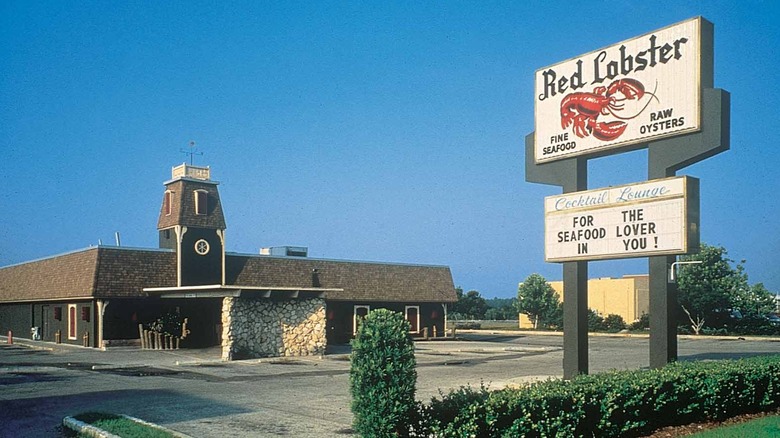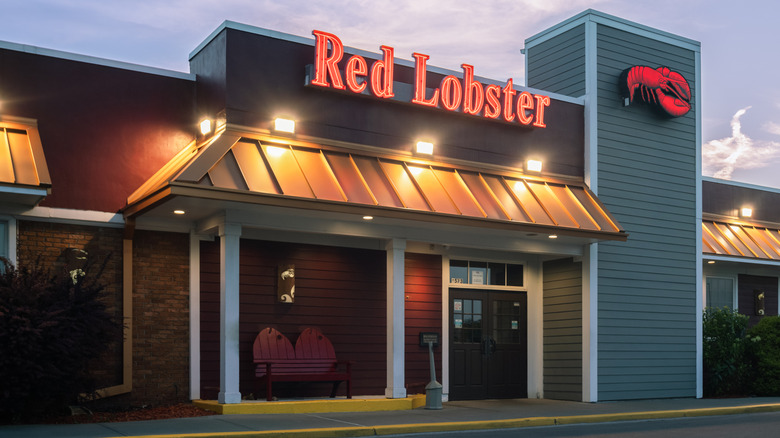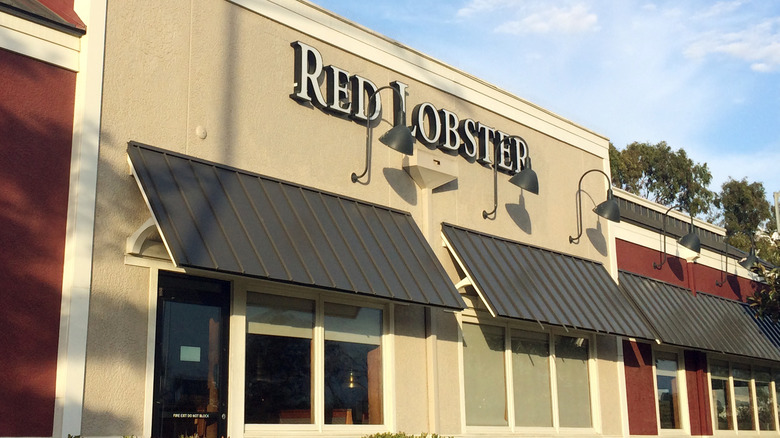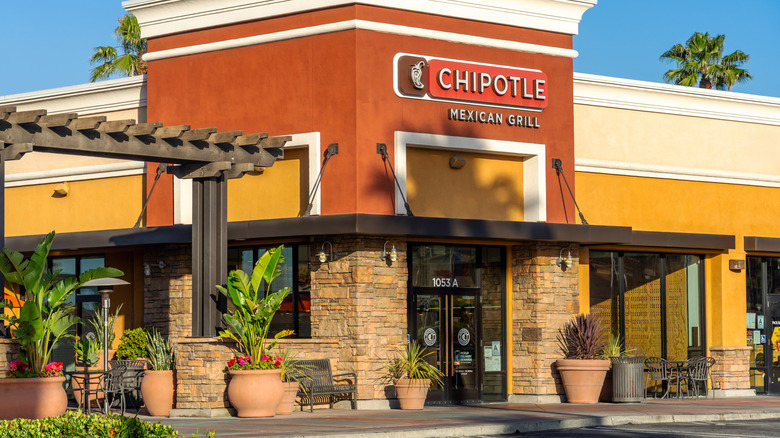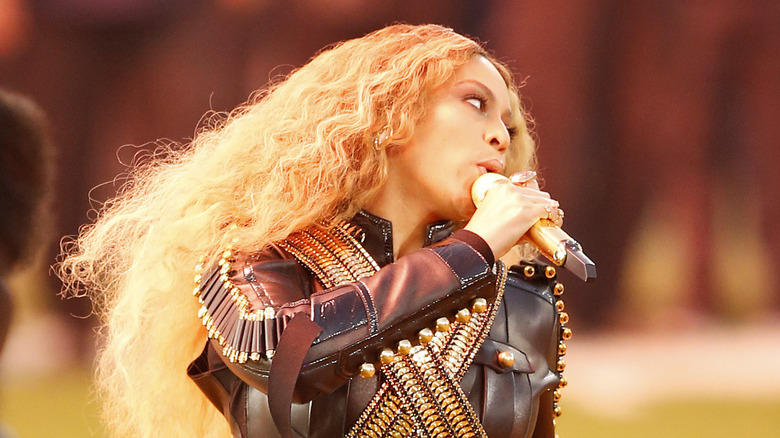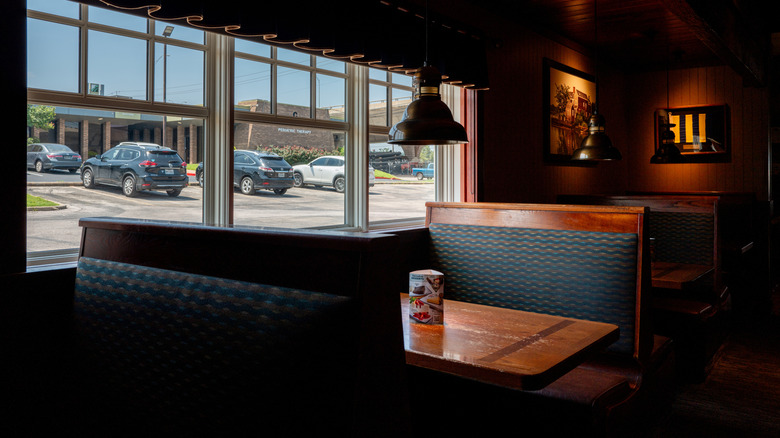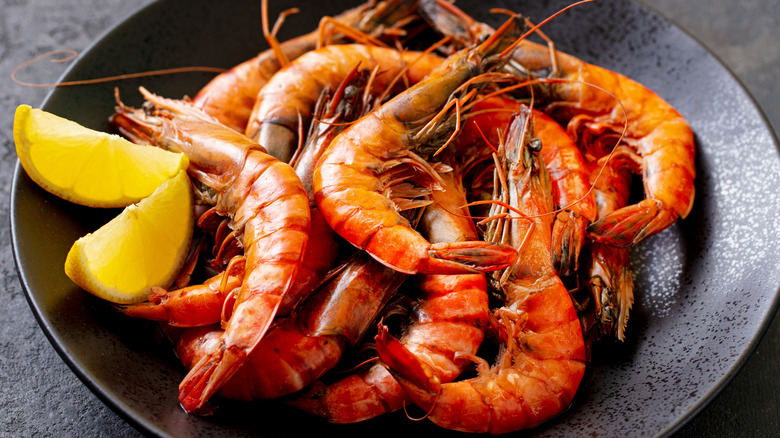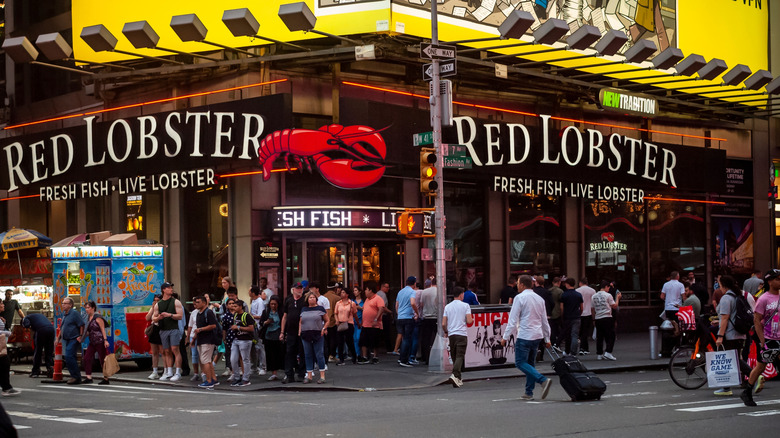The Only Recap Of Red Lobster's Downfall You Need
Red Lobster enjoyed a long reign as one of the most dominant and influential restaurants in American history. An early pioneer of casual dining chains, it ballooned in popularity throughout the 1980s and '90s, becoming the world's largest seafood chain. At its peak, Red Lobster operated more than 600 restaurants. However, the iconic brand slowly deteriorated until it abruptly closed nearly 100 locations, leaving the future of the restaurant in jeopardy.
But that wasn't the end of Red Lobster. The company filed for bankruptcy soon after the restaurant closures and emerged from the proceedings in September 2024 with new owners and a $60 million injection of investment money. The refreshed executive team is led by CEO Damola Adamolekun, whose resume includes two Ivy League degrees and guiding P.F. Chang's through the pandemic years as a first-time CEO. Red Lobster is plotting a comeback strategy, but for that to be successful, it will need to overcome challenges that have plagued the chain for decades.
The all-you-can-eat shrimp fiasco shouldered a lot of public blame for Red Lobster's downfall, but truthfully, that was only the knockout blow. The complete story is about corporate greed and years of neglect that led to the decay of a once mighty company. This saga spans decades of missteps made by a long line of owners. Here is the only recap you need of Red Lobster's downfall.
Red Lobster was a big deal
Before delving into the downfall, it's important to understand what a big deal Red Lobster was. Bill Darden opened the first location in 1968, in a small, landlocked town about an hour south of Orlando. He was already an experienced restaurateur when he founded Red Lobster and had previously invested in a few Howard Johnsons, which introduced him to a style he would mimic in his future restaurants. With Red Lobster, his ambition was to bring affordable seafood to areas far from the coast.
Two years later, General Mills bought the burgeoning chain and brought Darden into the fold as an executive, providing him with some necessary corporate backing. This support allowed Darden to expand Red Lobster to over 200 restaurants throughout the 1970s and establish the first nationwide seafood distribution network. Casual dining was extremely popular in the '80s and '90s, and Red Lobster continued to add locations. Darden clearly unlocked a formula that was popular with American diners: an informal atmosphere with family prices. It was an institution that provided the blueprint for other casual dining chains to follow. In its glory days, it was difficult to imagine that Red Lobster would be humbled to bankruptcy.
There were signs of trouble as early as 2008
It's hard to pinpoint exactly when an empire like Red Lobster starts to crumble. In 1995, General Mills established a standalone company for the restaurant side of its operations, naming it Darden Restaurants in honor of Bill Darden's recent passing. This company operated both Red Lobster and Olive Garden. While both chains thrived throughout the '90s, a visible indicator of trouble came in 2008, when Olive Garden's sales outpaced Red Lobster's. (In fact, it was only recently that Olive Garden was dethroned as America's top casual dining chain.) It wasn't just the Italian American chain putting pressure on the seafood chain, either. Darden Restaurants acquired other brands, including Longhorn Steakhouse and Capital Grille. Each restaurant required funding from the company for marketing, maintenance, and technology upgrades.
Increasingly, Darden chose to divert investments away from Red Lobster in favor of the faster-growing restaurants. Underinvestment sparked the beginning of a troubling trend for the business and was a key issue that current CEO Damola Adamolekun blamed for the company's demise. On a Wall Street Journal podcast, Adamolekun said, "I think, fundamentally, it's restaurants require investment to continue to grow, right? ... And when that investment doesn't take place, the brand can stagnate and start to decline." In 2014, under pressure from investors, Darden Restaurants sold Red Lobster to a private equity firm for $2.1 billion. The sale proved to be devastating for the chain.
The new owners made a devastating real estate deal
Some private equity firms have a notorious reputation for asset stripping. This is when a firm buys a company (like Red Lobster) and sells everything of value for short-term gains, thereby injuring the restaurant's long-term health. While the investors turn a profit, the company withers without the resources it needs. When the private equity firm Golden Gate Capital acquired Red Lobster in 2014, some of the investors' decisions crippled the seafood restaurant chain. Most notably, to finance the purchase of Red Lobster, Golden Gate sold many of the restaurants' properties.
Golden Gate signed a leaseback agreement with the owners of some 500 of the chain's locations, meaning the affected Red Lobsters were now tenants in the spaces they once owned and faced a significant new rent expense. In its bankruptcy filings, Red Lobster reported paying almost $200 million in rent in 2024, over a fourth of which went to underperforming locations. Additionally, the seafood chain claimed its rent prices were exorbitantly priced. Like a deadweight anchor, the real estate deal restrained Red Lobster and exposed the chain to additional threats.
The rise of fast casual restaurants increased competition
One of Red Lobster's biggest threats was the rise of fast casual restaurant chains. While Red Lobster was instrumental in popularizing casual dining restaurants before the new millennium, America's eating-out habits evolved, and fast casual restaurants emerged as fierce competitors. While the first fast casuals appeared in the 1990s, these chains are now ubiquitous in the U.S., with spots such as Chipotle, Panda Express, and Jersey Mike's on seemingly every corner. There are differences between fast food and fast casual restaurants, but the latter is a broad sector that even includes burger joints like Shake Shack and Five Guys. Typically, fast casual restaurants prepare higher-quality food, use fresh ingredients, and offer counter service rather than drive-thru. Healthy options are also popular, and chains such as the Mediterranean-inspired Cava are thriving.
One of Red Lobster's major challenges is luring fast casual diners into its booths. Our current dining culture is a different landscape compared to the '80s and '90s. In 2024, fast casual restaurants were the dominant sector, leading the industry with 9% sales growth compared to the paltry 1.3% growth for casual dining restaurants (via Restaurant Business). The pressure from fast casual competitors resulted in declining sales for establishments like Red Lobster, and the trend doesn't appear to be reversing. If Red Lobster wants to rebound, it needs to find a place in a dining era dominated by quick convenience and quality.
Beyoncé boosted sales when she released Formation
In 2016, the day before performing the Super Bowl halftime show, Beyoncé nearly broke the internet when she released "Formation" on YouTube. The video amassed over 7 million streams in the first 24 hours. In the song, she references taking a romantic partner to Red Lobster, and people took notice. The day after the song's release, restaurant sales skyrocketed by 33% compared to the same day a year prior. The seafood restaurant chain was also a trending topic on X (formerly known as Twitter) for the first time. "It's clear that Beyonce has helped create some Red Lobster fans, and we are very grateful to her for that," CEO Kim Lopdrup told CNBC.
Although it looked like good news served on a silver platter, the struggling chain fumbled the opportunity. It took Red Lobster more than eight hours to respond on social media, with a tweet that was lazy and underwhelming at best. Beyoncé presented Red Lobster with a golden ticket to go more viral than Dua Lipa's Diet Coke and pickle concoction, but it failed to capitalize. It was a potential sign that the chain was struggling to connect with customers and failing to adapt to the times.
The seafood supplier bought the business
Six years after purchasing Red Lobster and saddling them with suffocating rent expenses, Golden Gate Capital exited its investment in the company. A consortium led by Thai Union, a Bangkok-based seafood supplier, bought a controlling interest. Thai Union had invested in Red Lobster since 2016 but had also been one of the chain's biggest shrimp suppliers for over 20 years. What the seafood supplier didn't have, however, was experience running a restaurant chain. Referencing his time at Red Lobster under Thai Union, Les Foreman, the chain's former divisional vice president, told CNN, "It was miserable working there for the last year and a half I was there ... It was just a matter of (Thai Union) cutting costs everywhere they could." One example was asking servers to juggle 10 tables when they used to be responsible for three.
In the bankruptcy filings, Red Lobster also claims Thai Union pushed out other vendors to sell more of its own product. The full picture is murky, but it is possible there was more than a hint of conflict of interest. CEO Damola Adamolekun took the high road when he attributed the tension to Red Lobster's inexperience in the industry. "I have to believe (Thai Union) wanted to do as well as they could," he said in another CNN interview. "The fundamental problem is they're not restaurant operators. They're vendors for shrimp." Either way, under Thai Union's leadership, Red Lobster's deterioration accelerated until culminating in bankruptcy.
Red Lobster didn't recover after the pandemic
In the seafood supplier's defense, Thai Union obtained control of Red Lobster right when the COVID-19 pandemic was upending the restaurant industry. It was a difficult environment for everyone, especially a first-time restaurant operator with a chronically underinvested chain like Red Lobster. The pandemic shutdown accelerated trends that were already problematic for Red Lobster. It discouraged customers from dining in, pushing them instead toward takeout, delivery, and the fast casual chains that had already been growing in popularity.
The challenges created by the pandemic and evolving dining habits were more than Red Lobster could handle. In its 2024 bankruptcy filing, the seafood chain reported that guest counts were still well below pre-pandemic levels. (And it's not like things were looking great before 2020, either.) For a company already struggling with rising rent prices and increased market competition, the decreased traffic left it reeling toward a financial crisis.
Red Lobster struggled to expand its customer base
Even with the decreased guest count, Red Lobster reported annual sales of more than $2 billion the same year it declared bankruptcy. Some devoted customers were distraught by Red Lobster's plight. Flavor Flav attempted to save Red Lobster and made headlines by ordering the entire menu. The mayor of Danville, Illinois, made a heartfelt Facebook post after learning a local location had been closed. He thanked the staff and recalled the restaurant as a place the community had gone to celebrate special occasions for over 30 years.
Convincing customers to return was not a primary issue for Red Lobster. Instead, the failure to expand its customer base played a key role in the restaurant's downfall. "Red Lobster had incredible popularity among baby boomers. They didn't bring in a newer generation," Alex Susskind, a professor of food and beverage management at Cornell University, told ABC. According to CNN, close to half of Red Lobster's customers are over the age of 55. To overcome this challenge, the new management team's strategy centers on attracting new diners without alienating the loyal customer base. That means keeping flounder on the menu and bringing back beloved menu items like hushpuppies. It also means adding new menu items and updating the ambiance to attract younger generations.
There was a revolving door in the executive offices
When Red Lobster needed a captain to steady the ship, either nobody was there or too many people were there, depending on the perspective. Kim Lopdrup worked for Red Lobster in two stints over 14 years. He began as president when the company was still under Darden Restaurants and later became CEO after the sale to Golden Gate. Lopdrup remained in the position until his retirement in 2021. "I'm confident we are well-positioned to attract an outstanding new CEO who can lead Red Lobster to greatness over the next generation," Lopdrup wrote in his retirement announcement.
He was wrong. Instead, Red Lobster saw four CEOs in the three years between Lopdrup's retirement and the sudden restaurant closures in May 2024. Turnover wasn't confined to the CEO's office, but it was also rampant throughout the C-suite. Despite Thai Union's initial statement that they wouldn't be involved in everyday restaurant operations, that's not how it worked out. Thai Union inserted its own representatives into top positions at Red Lobster and exerted control over the restaurant's executives, pushing some of them to the exit. A company that once prided itself on long-tenured workers faced its fiercest test with inexperienced executives. Without a strong management team, Red Lobster was defenseless against the fateful all-you-can-eat-shrimp fiasco.
The all-you-can-eat shrimp fiasco delivered the knockout punch
While a combination of factors led to Red Lobster's downfall, the infamous all-you-can-eat shrimp deal was the final blow. It was an annual limited-time promotion that Red Lobster decided to make permanent, ostensibly to drive traffic to the restaurant. The offer succeeded in bringing customers, but they ate more shrimp than anticipated. The company suffered losses of $11 million in a single quarter, which were primarily attributed to the disastrous promotion. As Red Lobster sailed into bankruptcy, Thai Union abandoned its shares in the company.
The staggering financial losses dominated headlines, but current CEO Damola Adamolekun told the Wall Street Journal that the damage ran deeper. He explained that the all-you-can-eat offer exerted excessive pressure on kitchens and servers, causing wait times to surge and staff to quit. In addition, the promotion damaged Red Lobster's reputation. Adamolekun explained that when the public saw the chain promoting massive portions at discounted prices, they assumed Red Lobster was selling a low-quality product. The CEO also conceded that Thai Union (the shrimp supplier that owned the business at the time) could have had a vested interest in the endless shrimp promotion. "There's a case to be made that [Thai Union benefits] in some way or another if a lot of shrimp leaves the building, whatever it's priced at for the restaurant," he said on the WSJ podcast. Whether the decision was made with the best intentions or driven by ulterior motives, it proved ruinous for Red Lobster.
Red Lobster is making a comeback bid
Red Lobster is hoping for a successful comeback, but for that to happen, it needs to avoid the mistakes of the past. Despite the hurdles, there is optimism in the Red Lobster camp. "We wanted someone who was dynamic," Morgan McClure, the managing director of the brand's investment firm, told CNN. "[Adamolekun] can inject some energy into [Red Lobster] and is willing to roll up his sleeves and dig into the nitty gritty of it." Adamolekun is no stranger to challenges; as a first-time CEO at P.F. Chang's during the pandemic, he returned the company to profitability and surpassed $1 billion in annual sales.
Adamolekun is confident Red Lobster can make a similar turnaround. "It's on us to make this what I think can be the greatest comeback in the history of the restaurant industry," he said on a Wall Street Journal podcast. There have been some visible elements of the new strategy, like when Red Lobster launched a happy hour just in time for the holidays. The chain is also revamping the ambiance of its restaurants, including details like playing better music and creating a relaxed environment that reminds a new generation why casual dining was so popular in America. While there is reason for optimism, only time will tell if Red Lobster can reclaim its past glory, or if this is just the final chapter of its slow demise.
